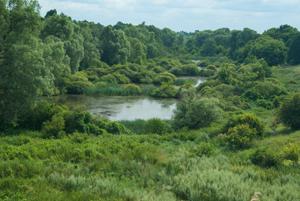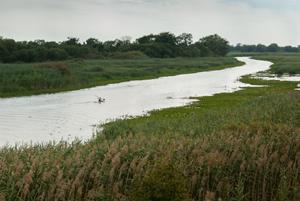Oksana Abduloieva
Other projects
30 Mar 2016
Implementation of the Measures to Restore and Manage Natural Habitats in the National Nature Park “Pyriatynskyi” (Central Ukraine)
The aim is to develop a guidance and accompanying materials for floodplain landscapes in order to provide conservation of vulnerable species and sustainable management on floodplains in the park.

Peat extraction happened in the past transformed floodplain environment and at the same time created new habitats for wildlife. ©Yuryi Shepeta, 2014.
Floodplains of the national nature park ‘Pyryatynsky’ are the temperate river valley geosystems of high vulnerability. There are habitats for hundreds of animal and plant species and among them - 30 animal and 6 plant species under national and international protection such as: mammals – European otter Lutra lutra, European beaver Castor fiber, hermine stoat Mustela erminea; birds – common crane Grus grus, white-tailed eagle Haliaeetus albicilla, western marsh-harrier Сircus aeruginosus, common stilt Himantopus himantopus, little bittern Ixobrychus minutus; turtles - European pond turtle Emys orbicularis; fish - burbot Lota lota, crucian carp Carassius carassius; butterfly Glaucopsyche teleius; dragonfly Anax imperator; plants – orchids Dactylorhiza incarnata, Dactylorhiza majalis, Orchis palustris, Epipactis palustris, the sword lily Gladiolus tenuis, water fern Salvinia natans, the plants under regional protection susceptible to floodplain condition – Nymphaea alba, Nymphaea candida, Utricularia vulgaris, Menyanthes trifoliata, Parnassia palustris, Comarum palustre. All these habitats need to be monitored and main landscape-influencing factors are to be defined as well. By this way we expect to find the ways for sustainable management of the given floodplain in general and vulnerable habitats in particular. Most attention will be devoted to wetlands, floodplain meadows and reed marshes which feature the greatest meaning for conservation of biodiversity and floodplain sustainability.

The important outcomes of the work will be GIS data of the floodplain landscapes, landscape estimation and finding of critical changes, guidance for management scheme in floodplain and action plans for conservation of vulnerable species, increasing environmental competence within local community and building capacity of the park and its staff. The project execution will be based on landscape planning methodology. The project team includes experts in landscapes and biodiversity, founder of the national nature park and nature protection activists, but there will be also involved other stakeholders.